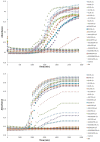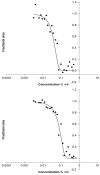Evaluation of Plant Origin Essential Oils as Herbal Biocides for the Protection of Caves Belonging to Natural and Cultural Heritage Sites
- PMID: 34576731
- PMCID: PMC8470480
- DOI: 10.3390/microorganisms9091836
Evaluation of Plant Origin Essential Oils as Herbal Biocides for the Protection of Caves Belonging to Natural and Cultural Heritage Sites
Abstract
The present study concerns the serious issue of biodeterioration of the caves belonging to natural and cultural heritage sites due to the development of various microorganisms. Thus, a series of 18 essential oils (EOs) extracted from various Greek plants were evaluated in vitro (concentrations of 0.1, 0.2, 0.5, 1.0 and 5.0% v/v) against 35 bacterial and 31 fungi isolates (isolated from a Greek cave) and the antimicrobial activity was evident through the changes in optical density of microbial suspensions. In continuance, eight (8) representative bacterial and fungal isolates were further used to evaluate the minimum inhibitory concentration (MIC) and non-inhibitory concentration (NIC) values of the most effective EOs. According to the results, two EOs of Origanum vulgare were the most effective by inhibiting the growth of all the tested microorganisms at 0.1% (v/v), followed by that of Satureja thymbra which inhibited all bacterial isolates at 0.1% (v/v) and fungal isolates at 0.1, 0.2 and 0.5% (v/v) (depending on the isolate). The MIC ranged between 0.015-0.157 and 0.013-0.156 (v/v) for the bacterial and fungal isolates respectively, depending on the case. The current study demonstrated that conventional biocides may be replaced by herbal biocides with significant prospects for commercial exploitation.
Keywords: MIC; NIC; caves; essential oils; natural biocides.
Conflict of interest statement
The authors declare no conflict of interest. The funders had no role in the design of the study; in the collection, analyses, or interpretation of data; in the writing of the manuscript, or in the decision to publish the results.
Figures


References
-
- Tomczyk-Żak K., Zielenkiewicz U. Microbial diversity in caves. Geomicrobiol. J. 2016;33:20–38. doi: 10.1080/01490451.2014.1003341. - DOI
-
- Taylor E.L.S., Resende-Stoianoff M.A.R., Lopes Ferreira R. Mycological study for a management plan of a neotropical show cave (Brazil) Int. J. Speleol. 2013;42:267–277. doi: 10.5038/1827-806X.42.3.10. - DOI
-
- Lamprinou V., Danielidis D.B., Pantazidou A., Oikonomou A., Economou-Amilli A. The show cave of Diros vs wild caves of Peloponnese, Greece-distribution patterns of Cyanobacteria. Int. J. Speleol. 2014;43:335–342. doi: 10.5038/1827-806X.43.3.10. - DOI
LinkOut - more resources
Full Text Sources

